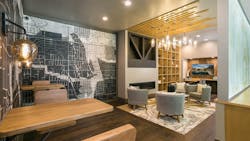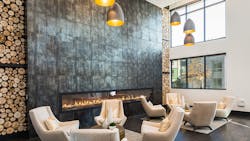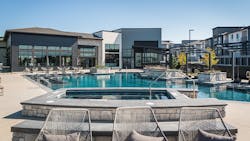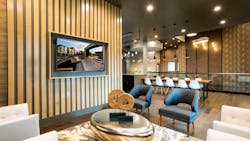4 Multifamily Trends that Blend into Hospitality
When considering the ways in which crossover is occurring across sectors of design, an important aspect is in understanding the ways in which people expect to live. As amenity spaces grow throughout office and hospitality design, so are they expanding in multifamily locales.
Angela Harris, CEO and principal of design firm TRIO, has been working along the line between hospitality and multifamily for nearly 20 years since opening her company. Working with builders and developers, Harris and her team collaborate to create master planned communities, model homes, clubhouses, sales centers, commercial and hospitality projects, and multifamily apartment communities.
As the boundaries between design for residential and commercial continue to blur, Harris has noticed growing trends in what users expect from both.
“There’s a direct correlation between hospital design really influencing multifamily and multifamily influencing master plan community buildings,” she says.
What’s more: Understanding the elements desired in a multifamily development can help healthcare community designers to get ahead of the trends of what their residents will soon be expecting.
Amenities and amenity spaces
Amenities and amenity spaces are becoming one of the most asked-for elements of multifamily developments.
“There’s a huge shift toward [multifamily housing] providing an experience and a lifestyle toward residents,” Harris explains. “Before, [an apartment building] had to look pretty and it was very aesthetically pleasing, and people got very excited about the design of the space. But now we’re seeing a fusion with what types of services and amenity components can be programmed in the space so that it’s not only beautiful but causes a lifestyle and ease of living that they can’t find anywhere else.”
These amenities don’t just end with a clubhouse or fitness center. Increasingly, pets are a priority, leading to the integration of doggie daycares and dog parks on the property. Often seen as an equal member of the family, condo owners and renters want to see they’re as taken care of as the humans in the home.
Another amenity that’s growing in popularity is concierge services. Although anyone with an internet connection can easily Google locations or set appointments, the human element of a concierge gives residents peace of mind.
Just as the design industry is seeing across the board, health and wellness is a priority to the multifamily community. One out-of-the-box aspect that Harris has seen is the trend toward the creation of meditation spaces. This can be designed as either a solitary location such as a “meditation pod” or communal spaces created to unwind.
Elevating Sophistication
The aesthetic of multifamily is changing as well to match the luxury hotel experience, particularly when it comes to elevating the sophistication.
“When you walked into a high-end hotel, there was really a strong elevated intensity when it came to design,” Harris says, “whether it was around arts or sculpture or different architectural detailing. All of that has filtered down to multifamily.”
The intention is to create a space that won’t look out of date in a few years by using more timeless details. “Before when we did multifamily, the concept was that they were going to turn the property over in five to seven years, and it would have to be redesigned. Now we’re looking at how do we make this last 10 or 20 years, and make it more of an iconic environment?”
Local Vibes
One element of creating more iconic environments is to include a local feel to the space, whether through material, color or works by local artists.
In designing toward a specific market, Harris says, “Instead of having a mainstream three-color pallet in an apartment complex, you walk in now and [the space has] integrated local artists; it’s integrated in the community. It’s really captured the heart of where the actual apartment is.”
To do this, the team at TRIO spends time in the town, attending local art shows, visiting studios and understanding what elements characterize the city itself.
In the end, the focus is on how users react to the hotel or multifamily development. “It all starts with the experience and how the residents or guests feel when they walk into the space,” she notes.
► Daily Design News | 5 Contemporary Designs that Celebrate Hanukkah
About the Author

Kadie Yale
Former Editor-in-Chief
Kadie Yale holds a BA in Industrial Design from San Francisco State University and a MA in Decorative Art History and Theory from Parsons the New School. In her role as editor-in-chief from 2015-2018, she led the interiors+sources team in creating relevant content that touches on sustainability, universal design, science, and the role of design in society.




